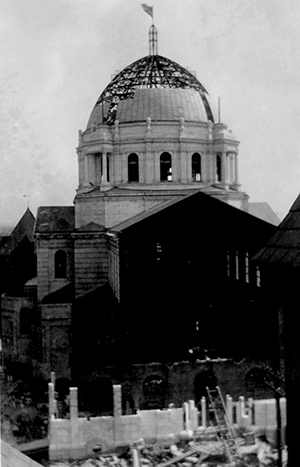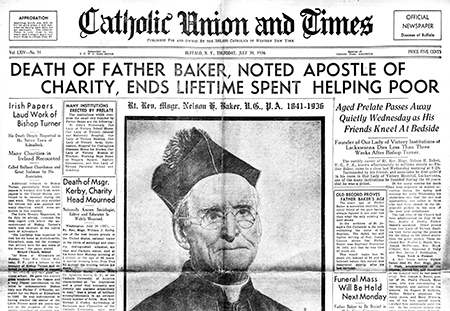A Hero Until the End
 His “City” expanding quickly, Father Baker’s body began to slow down, but the humble priest still had a few things left on his “to do” list! One of them – his biggest dream yet – had been in his mind since his pilgrimage to Europe when he was in the seminary.
His “City” expanding quickly, Father Baker’s body began to slow down, but the humble priest still had a few things left on his “to do” list! One of them – his biggest dream yet – had been in his mind since his pilgrimage to Europe when he was in the seminary.In August of 1921, Father Baker joined hundreds of priests, religious sisters and politicians at a special ceremony to bless the new shrine’s cornerstone. With that, construction began and, after countless hours of work, Our Lady of Victory Shrine was completed and hosted its first Mass on Christmas Day in 1925.
As expected, construction of such a landmark was expensive. Estimates say it cost anywhere between $2.8 to $3.8 million in 1925 dollars. But with help from supporters throughout the country (and Father Baker’s business savvy) the project was fully paid for by the time of its completion.
On May 25, 1926, a celebration was held as the church was dedicated. In July of that year, the pope named OLV Shrine a minor basilica, making it just the second basilica in the United States at the time.
A Hero Rises…
The Wall Street Crash of October 1929 ushered in the Great Depression, years that scarred the nation and its people. Thousands were left destitute, hungry and/or homeless. Western New Yorkers were not immune to the suffering. For many of them, though, a hero arose: Father Baker.
Those records that have been left behind from that era tell a story of a bustling "City of Charity" that did more good than can be imagined. Diocesan records from the first three years of the 1930s estimate that, during this terrible time period, more than 450,000 meals were served and approximately 20,000 nights of free lodging for the homeless were provided.
Father Baker’s generosity went beyond food and shelter. Between 1930 to 1933, “Father Baker’s Boys” (the nickname given to those who grew up in his institutions) had made and distributed more than 4,600 pairs of shoes, 2,100 coats, 800 men’s suits, 1,100 women’s dresses, 1,200 sets of underwear and 300 pairs of children’s shoes.
He wasn’t done, though. During a time in which he was bed-ridden due to an injury, he looked down from his room at the lines of needy folks gathered for food distribution and noticed several people of color talking with the priests. He sent word down to ask if these individuals would be interested in becoming Catholic. They were.
The very next month, now recovered, Father Baker began what is referred to as the Black Apostolate. The first class included 30 men, women and children. That number grew quickly. By the end of 1932, its first full year, 500 individuals had gone through the program resulting in 333 baptisms, 291 First Communions and 204 Confirmations. By the summer of 1935, nearly 700 baptisms were performed and at least seven weddings had taken place between people who had met during classes. His work went beyond spiritual assistance, though, as those participating in the program received food, clothing and even housing when needed.
And, in 1932, he teamed up with several community leaders to establish the Working Girls’ Home in downtown Buffalo. It provided housing to young women who were temporarily out of work and needed a place to stay until they found a job. It was such a success that, three years later, a second home was opened.
 …and Falls
…and Falls
Eventually, age caught up with the man who was dubbed the "Padre of the Poor" by local newspapers.
His health had deteriorated during the first part of 1936 and he lapsed into a coma on July 29. He breathed his last that morning while being blessed by Father Joseph Burke, who would later go on to become bishop of Buffalo.
His life had been so impactful, that it is estimated that close to 500,000 people came to pay their respects to the humble priest as he lie in state. His funeral service was broadcast live on local radio stations and attended by countless thousands of well-wishers, friends, men and women religious, and community leaders.
One government official summed up the feeling of those who had gathered best:
A man’s success in life should be measured by the friends he makes and the good he does. Measured by this rule, Father Baker was the most successful man in this country and, probably, the world.


